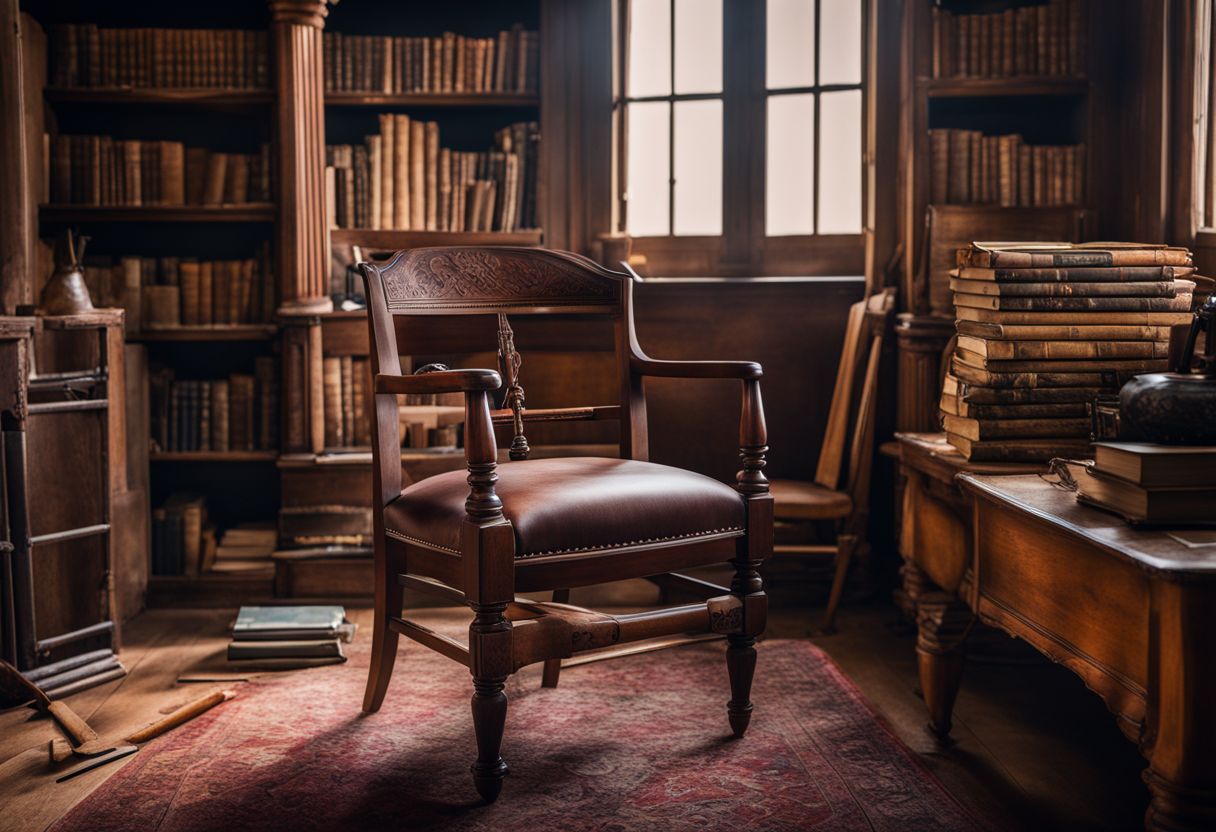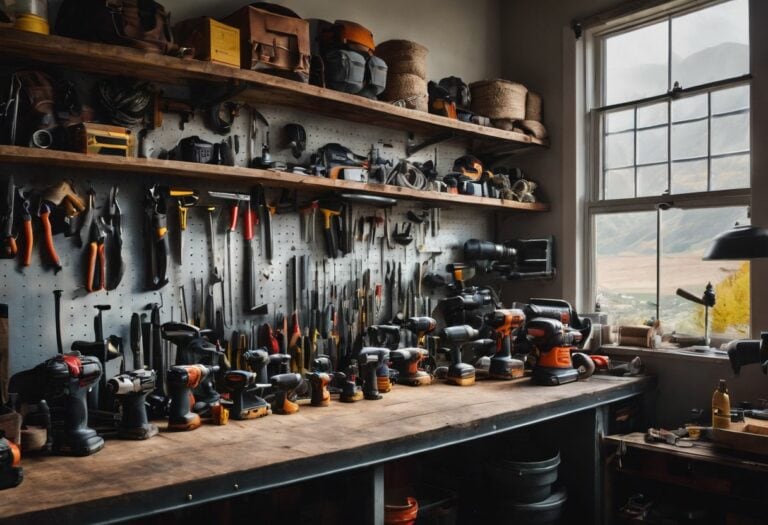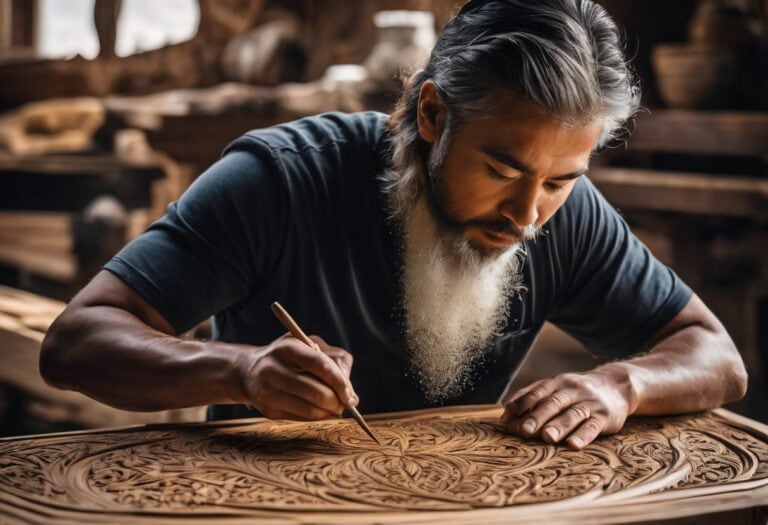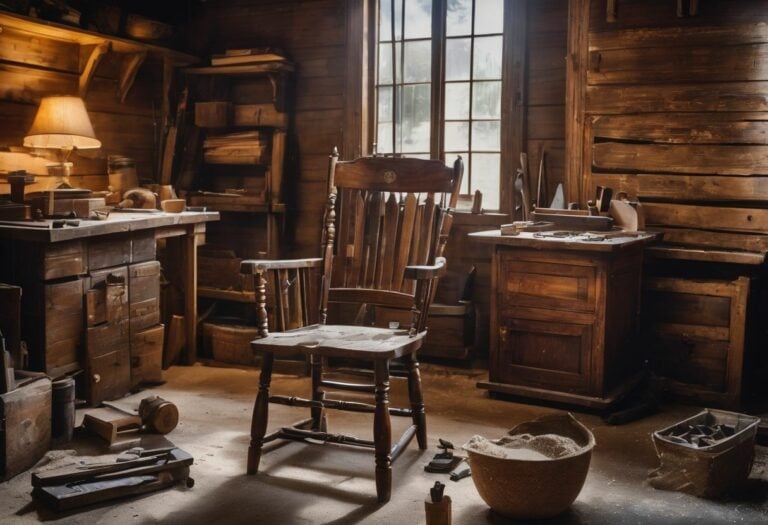When Not to Restore an Antique: A Guide for Making the Right Decision
Diving headfirst into the fascinating realm of antiques can certainly feel a bit like trying to unravel an intricate puzzle, especially when it comes to making that all-important decision – should you restore an item or let it be? Just like you, I’ve navigated these tricky waters and learned that a wrong restoration move can spell disaster for your treasured heirlooms, significantly diminishing their value.
In this article, we’ll venture together through some key strategies in identifying when restoring is beneficial and when it’s best to allow an antique its unaltered charm and authenticity.
So buckle up! You’re about to become a savvier guardian of historical treasures with this comprehensive guide.
Key Takeaways
- Understanding the value of antiques is important in deciding whether to restore them or not. Factors like age, rarity, condition, and historical significance all affect their worth.
- Restoring an antique can decrease its value if it removes special marks or signs of age that make it valuable. Using bad restoration methods can also harm the piece and lessen its worth.
- Before starting a restoration project, conduct research on the history and value of the antique piece, consult with professionals for guidance, and set a budget to ensure a successful restoration process.
- When considering refinishing an antique, think about its age and rarity. Older and rarer pieces are often more valuable when left as they are because collectors appreciate their flaws as signs of age and character.
- Damages that can be repaired without decreasing the value include scratches on the surface, loose joints that can be re-glued or tightened, missing or broken hardware that can be replaced with period-appropriate pieces, stains or discoloration that can be treated without harming the original finish, and small chips or dents that can be filled.
- Personal preferences and use should guide decisions about refinishing an antique. Consider how you plan to use it in your home – as a functional item or display piece – before deciding whether refinishing is necessary.
- Leave an antique as-is if it has historical significance so as not to disturb its original integrity. Preserving antiques with well-preserved finishes increases their value while leaving them untouched honors their contribution to history.
- If an antique is part of a collection, carefully consider restoration options based on its condition and originality. Some pieces may benefit from restoration while others may lose value.
When Not to Restore an Antique: Understanding the Value of Antiques

Factors such as age, rarity, condition, and historical significance all play a role in determining the value of antiques.
Factors that affect the value
Here is a list of things that can change how much an antique is worth.
- Age: Older items often have more value.
- Rarity: If few items like it exist, the price goes up.
- Condition: Items in good shape are worth more.
- Restoration Quality: Good fixes add to the item’s worth.
- Provenance: If we know who owned it or where it came from, it may be worth more.
- Historical Significance: If the item played a part in history, its value could be high.
- Original Features: Keeping parts that came with the piece when new adds to its value.
When restoration can decrease value
Fixing old things is not always good. Sometimes, changing a piece can lower its worth. This happens a lot with antiques. Some antiques have marks or signs of age that make them special.
If you take these off, the item may lose its charm and value.
A wrong move can harm an antique badly. Using bad methods or ways to fix it can damage the piece forever. The harm done might lessen how much people want it for and decrease its worth greatly! So be careful and seek expert help when unsure about restoring antiques.
What to Do Before Tackling a Restoration Project

Before embarking on a restoration project, it is crucial to conduct thorough research on the history and value of the antique piece, consult with professionals for advice and guidance, and set a budget to ensure a successful restoration process.
Researching the history and value of the piece
Knowing the past of an antique piece is key. It tells us more about its worth. I look for old marks, labels, or signs that show who made it and when. Books on antiques help too. They tell me about different styles and makers from long ago.
Big auction sites are also good to check out what similar items have sold for recently. It helps in knowing if it’s rare or not so special after all. Talking to professionals can shed light too as they know a lot about such stuffs.
Consulting with professionals
Before tackling a restoration project, it’s crucial to consult with professionals who have expertise in antique restoration. Seeking guidance from these experts can help you make informed decisions and avoid costly mistakes.
Engaging with professional consultants ensures that you receive the best advice for your specific project, whether it’s restoring a piece of furniture or preserving a historical home.
Their input is valuable in determining the appropriate restoration techniques, setting realistic expectations, and understanding the potential value of the finished product. By prioritizing professional advice, you can increase the chances of successfully restoring your antique while maintaining or even enhancing its value.
Setting a budget
Before diving into a restoration project or deciding whether to restore an antique, it’s crucial to establish a budget. Financial planning is essential to ensure that the project expenses stay within your means.
By setting a budget, you can estimate the costs involved in the restoration process and allocate funds accordingly. It’s also helpful to do some research on similar projects from the past to better understand historical budgets and get an idea of what you might be looking at in terms of expenses.
With a well-defined budget in place, you can confidently move forward with your antique restoration knowing exactly how much you’re willing to invest in it.
When to Refinish an Antique
Refinishing an antique is appropriate when considering the age and rarity of the piece, determining if damages can be repaired without decreasing value, and taking personal preferences and use into account.
Age and rarity of the piece
The age and rarity of an antique piece play a crucial role in determining whether to refinish it or not. Older and rarer pieces are often more valuable and should be preserved as much as possible.
Antique furniture with unique features, such as intricate carvings or original hardware, can be harmed by restoration efforts. Collectors appreciate the flaws in antique furniture as they see them as signs of age, value, and character.
The patina, or surface wear and oxidation, on these pieces provides evidence of their age and history, adding to their value. It is important to respect the authenticity of these antiques by carefully considering whether refinishing is necessary or if maintaining their original condition will better preserve their historical significance.
Damages that can be repaired without decreasing value
There are certain damages to an antique that can be repaired without decreasing its value. Here are some examples:
- Scratches on the surface that can be buffed out or polished
- Loose joints that can be re – glued or tightened
- Missing or broken hardware that can be replaced with period – appropriate pieces
- Stains or discoloration that can be treated or removed without harming the original finish
- Small chips or dents that can be filled and blended in with the surrounding surface
Personal preferences and use
When deciding whether to refinish an antique, personal preferences and use are important factors to consider. Your own taste and style should guide your decision-making process. Think about how you plan to use the piece in your home.
Will it be a functional item or more of a display piece? This will help determine whether refinishing is necessary or if leaving it as-is is the better option. Also, consider how the restoration may affect its value.
While some antiques can benefit from refinishing, others may lose their charm and value in the process. Ultimately, it’s up to you to decide what works best for your personal preferences and intended use of the piece.
When to Leave an Antique As Is
Leave an antique as is when it has historical significance, the original finish adds to its value, or if it is part of a collection. Read on to learn more about preserving the integrity of valuable antiques.
When the piece has historical significance
Preserving antiques with historical significance is crucial in maintaining their value and preserving our history. These pieces hold a special place in time, representing important events or people.
Restoring them may disturb the original integrity and diminish their historical value. For museum-quality antiques, it’s best to leave them as they are, respecting their age and unique characteristics.
By keeping these pieces untouched, we honor their contribution to our past and ensure they continue to be treasured for generations to come.
When the original finish adds to its value
Preserving the original finish of an antique can actually increase its value. This means leaving the furniture as it is, without altering or modifying its appearance. By retaining the untouched and unspoiled finish, you are maintaining the piece’s historical integrity and authenticity.
Expert appraisers recommend this approach to keep antiques in top condition and to ensure that their true value shines through. So, if you come across an antique with a unique and well-preserved finish, it’s best to leave it untouched to maximize its worth.
If the piece is part of a collection
If you have an antique that is part of a collection, it’s important to carefully consider whether or not to restore it. When an antique is part of a collection, its value may be affected by restoration.
The condition and originality of the piece are key factors to think about. Some antiques, especially those made with veneer over wood, may not be suitable for staining and should be left as is if they are part of a collection.
On the other hand, there might be some furniture within the collection that could benefit from restoration. It all depends on whether the time, effort, and cost of restoring the piece will ultimately increase its value in the collection.
The Dangers of DIY Restoration
DIY restoration of antiques can be risky, as improper techniques can damage the piece and decrease its value. Professional expertise is crucial to ensure the proper preservation and restoration of these valuable items.
Risk of damaging the piece
Restoring an antique can be risky, especially if you don’t have the right skills and knowledge. Trying to fix it yourself without proper expertise could lead to further damage. Each piece is unique and requires special care, so it’s essential to take precautions and seek professional help when needed.
Remember, improper restoration techniques can decrease the value of the item or even ruin it completely. If you want to preserve its historical significance and maintain its original integrity, trust experts who specialize in antique conservation and restorative craftsmanship.
Decreasing its value with improper techniques
Using improper techniques during the restoration of an antique can actually decrease its value instead of enhancing it. It is important to understand that certain methods may cause irreversible damage or alter the original craftsmanship, which collectors and enthusiasts highly value.
DIY restoration without proper knowledge and expertise can be risky, as you might accidentally damage the piece further. It is always advisable to consult with antique experts who have experience in restoring similar items using proper techniques.
The importance of professional expertise
Professional expertise is essential when it comes to restoring antiques. Restoring an antique requires a deep understanding of the piece’s history, materials, and original craftsmanship.
Professionals have the knowledge and skills needed to assess the condition of the antique accurately and determine the best restoration approach. Their expertise ensures that the restoration work is done correctly, preserving both the value and integrity of the piece.
Attempting DIY restoration without proper knowledge can lead to irreversible damage or improper techniques that decrease its value. It is always recommended to seek professional help for restoring antiques to avoid potential issues and ensure high-quality results.
Evaluating the Cost of Restoration
When determining whether to restore an antique, it is crucial to evaluate the cost of restoration based on factors such as the current condition of the piece, the extent of damage, and the availability of materials.
Factors that affect the cost
The cost of restoring an antique can be influenced by several factors. Here are some important factors to consider:
- Feasibility: The complexity of the restoration project can impact the cost. Some pieces may require more extensive work, specialized materials, or skilled labor, which can increase the overall cost.
- Materials and resources: The availability and cost of necessary materials, such as specific paints, finishes, or hardware, can affect the restoration cost. Scarce or hard-to-find materials may be more expensive to acquire.
- Expertise and labor: Restoring an antique often requires the skills and knowledge of experienced professionals. The cost of hiring experts or craftsmen for repairs and refinishing will contribute to the overall restoration cost.
- Timeframe: The duration of the restoration project can impact the cost. Longer projects may incur additional expenses for storage or temporary relocation if needed.
- Condition and extent of damage: The severity and extent of damage to the antique will influence the restoration cost. More significant damage or structural issues may require more extensive repairs and higher costs.
- Complexity of design: Intricate or highly detailed antiques may require more meticulous workmanship during restoration, leading to increased costs.
- Historical significance: If an antique has historical importance or is associated with a notable individual or event, preserving its authenticity and historical value might involve more specialized conservation techniques and higher costs.
- Market demand: The popularity and desirability of certain types of antiques can also affect their restoration costs. Rare or sought-after pieces may command higher prices for restoration due to increased demand.
When restoration may not be worth the investment
Sometimes, restoring an antique may not be worth the money you invest. Factors such as the age and rarity of the piece, along with any potential devaluation post-restoration, should be considered.
It is important to evaluate if the original finish adds value or if the piece has historical significance that should be preserved. Another consideration is whether it is part of a collection where leaving it as-is contributes to its overall value.
Before deciding on restoration, carefully assess these aspects to determine if it’s truly worth the investment.
Preserving Historical Homes and Antiques
Preserving historical homes and antiques requires striking a balance between maintaining authenticity and practicality.
The importance of maintaining authenticity
Preserving historical homes and antiques is crucial for maintaining the authenticity and character of a city or community. When we preserve these pieces, we are honoring our cultural heritage and ensuring that future generations can learn from them.
Restoring historic buildings helps us connect with the past and appreciate the craftsmanship of previous eras. By using authentic materials and techniques, we can accurately recreate the essence of those time periods.
It’s important to integrate considerations for preserving historical sites into hazard mitigation planning to protect these valuable pieces for years to come.
Balancing preservation with practicality
Preserving historical homes and antiques requires finding a balance between honoring the past and adapting to modern needs. It’s important to consider the practicality of preservation efforts while still respecting the historical significance of these treasures.
By implementing building codes that enforce preservation standards while accommodating contemporary design, we can achieve a harmonious blend of old and new. This allows us to maintain the authenticity and cultural heritage of these spaces, while also ensuring they are functional for today’s world.
Common Furniture Damage and How to Address It
Furniture damage is a common issue with antiques, but there are ways to address it properly.
Tips for preventing damage
As a furniture conservator, I have learned some valuable tips for preventing damage to antique furniture. Here are some important things to keep in mind:
- Minimize exposure to direct sunlight: Sunlight can fade and damage wood finishes over time. Position your furniture away from windows or use curtains or blinds to block out harmful UV rays.
- Use coasters and placemats: Protect your furniture from water rings and heat marks by using coasters under drinks and placemats under hot dishes. This simple step can prevent unsightly damage.
- Avoid dragging or sliding: When moving furniture, always lift it instead of dragging or sliding it across the floor. This will prevent scratches on both the furniture and the floor.
- Regular dusting: Dusting your antique furniture regularly with a soft cloth or feather duster helps prevent dirt and debris from settling into crevices, which can lead to long-term damage.
- Keep away from extreme temperatures: Extreme temperatures can cause wood to expand or contract, leading to cracks and warping. Avoid placing your antique furniture near sources of heat or cold, such as radiators or air conditioning vents.
- Handle with care: When handling delicate pieces, take extra care to support them properly and avoid putting unnecessary strain on joints or delicate areas.
- Maintain humidity levels: Fluctuations in humidity can cause wood to swell or shrink, leading to structural instability. Use a humidifier in dry climates and a dehumidifier in humid climates to maintain consistent humidity levels.
- Avoid using harsh chemicals: Harsh chemicals can strip away the natural oils in wood finishes and cause irreversible damage. Stick to mild cleaners specifically designed for wood when cleaning your antique furniture.
Proper ways to repair and maintain antiques
When restoring and maintaining antiques, it is important to handle them with care. Here are some proper ways to repair and maintain antiques:
- Clean gently: Use a soft cloth or brush to remove dust and dirt from the surfaces of antique furniture.
- Repair instead of replacing: Instead of replacing damaged parts, try repairing them using appropriate adhesives like Elmer’s glue or professional-grade wood glue.
- Avoid harsh chemicals: Use mild soap and water solutions or specialized wood cleaners for cleaning antique furniture. Harsh chemicals can damage the finish or surfaces.
- Keep away from direct sunlight: Exposure to direct sunlight can cause fading and discoloration in antique furniture. Place them in areas away from windows or use curtains to block out sunlight.
- Handle with care: When moving or rearranging antique furniture, be cautious to avoid any bumps or scratches that may damage the piece.
- Maintain humidity levels: Extreme changes in humidity can cause damage to antique furniture. Use humidifiers or dehumidifiers to maintain a stable level of humidity in your home.
- Regular inspections: Periodically inspect your antiques for any signs of damage, loose joints, or cracks. Addressing these issues early on can prevent further damage.
- Professional assistance: If you are unsure about how to repair or restore an antique, seek advice from professional restorers who have expertise in handling different types of antiques.
Conclusion
In conclusion, knowing when not to restore an antique is crucial for making the right decision. Understanding the value of antiques and considering factors like historical significance and original finish can help preserve their authenticity.
It’s important to consult professionals, set a budget, and weigh the costs of restoration before taking on a project. By making informed choices, antique owners can ensure that they are preserving their treasures for future generations to enjoy.
FAQs
1. How do I know if I should restore an antique?
You should consider restoring an antique if it has sentimental value, historical significance, or if the restoration will enhance its beauty and functionality.
2. Are there any situations where restoring an antique is not recommended?
Yes, restoring an antique may not be recommended if it would significantly alter its originality or decrease its value as a collectible item.
3. What factors should I consider before deciding to restore an antique?
Before deciding to restore an antique, you should consider its condition, rarity, uniqueness, cultural significance, and potential cost of restoration compared to its current value.
4. Should I attempt to restore an antique myself?
Unless you have experience and expertise in antique restoration techniques, it is generally best to leave the restoration process to professional conservators to ensure proper care and preservation.
5. Can every damaged or worn-out antique be restored?
Not every damaged or worn-out antique can be fully restored due to various factors such as extensive damage beyond repair or the unavailability of original materials necessary for restoration purposes.







